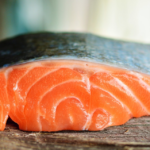As lovers of juicy, flavorful burgers, we’ve all been there – standing at the grill or ordering at a restaurant, faced with the decision of how we want our burger cooked. Medium rare is undoubtedly a popular choice for those who want their meat cooked just enough to retain its tenderness and flavor. However, it’s also a controversial choice that raises questions about food safety. So, is it safe to eat burgers medium rare? Let’s explore the science behind cooking meat and different opinions on safe internal temperature to find out.
Understanding the risks of undercooked meat is crucial in deciding whether or not you should indulge in a medium rare burger. The consumption of raw or undercooked meat can lead to foodborne illnesses caused by bacteria such as E.coli and Salmonella. These bacteria can cause symptoms ranging from mild stomach discomfort to severe illness and even death in vulnerable populations like young children, pregnant women, and older adults.
With this in mind, it’s important to understand what makes a medium rare burger ‘medium rare’ and why some people consider it safe while others don’t.
Key Takeaways
- Cooking burgers to a temperature of at least 160°F (71°C) is necessary to eliminate harmful bacteria and prevent foodborne illnesses.
- High-quality, grass-fed beef from reputable sources can reduce the risk of contamination and improve overall nutrition.
- Organic or grass-fed meat tends to be healthier and of higher quality, making it a better option for safely enjoying a medium rare burger.
- Proper preparation and cooking techniques, including using a meat thermometer and allowing the burger to rest before serving, are crucial in ensuring the safety of ground beef consumption regardless of its level of doneness.
Understanding the Risks of Undercooked Meat
You’re risking your health by chowing down on that juicy, pink burger because undercooked meat can lead to serious foodborne illnesses. Health risks associated with eating undercooked meat include food poisoning caused by bacteria like E. coli, salmonella, and listeria.
Symptoms of food poisoning can range from mild stomach upset to severe dehydration and even death in extreme cases. The danger lies in the fact that harmful bacteria may be present in raw or undercooked meat and cooking it at a high temperature is necessary to kill these microorganisms.
Eating a medium rare burger may be tempting for its taste but the risk of consuming harmful bacteria is not worth the gamble. It’s always best to cook meat thoroughly and avoid any potential health hazards associated with undercooked meat consumption.
The Science Behind Cooking Meat
As we continue our exploration of cooking meat, the science behind it is fascinating. One key factor that determines whether meat is safe to eat or not is temperature. Cooking meat to the right internal temperature can kill harmful bacteria and ensure its safety for consumption.
Additionally, how we cook the meat affects its texture and flavor, making it important to understand the chemical reactions that occur during cooking.
Why Temperature Matters
Properly cooking a burger to the appropriate temperature is crucial for ensuring food safety and avoiding potential health risks. When it comes to burgers, we often see requests for medium rare or even rare meat. However, consuming undercooked meat can lead to foodborne illnesses such as E. coli and Salmonella. Here are four reasons why temperature matters:
-
Pathogens are killed at specific temperatures: Cooking meat to an internal temperature of 160°F (well done) kills most bacteria that cause foodborne illness.
-
Benefits of sous vide: Sous vide cooking allows you to cook meat at lower temperatures for longer periods, resulting in a tender and flavorful texture without compromising on food safety.
-
Importance of meat sourcing: Choosing high-quality, grass-fed beef from reputable sources can reduce the risk of contamination and improve overall nutrition.
-
Personal preference should not come before food safety: While some people may prefer their burgers cooked less than well done, it’s important to prioritize health over taste preferences.
Properly cooking burgers is essential for preventing foodborne illnesses. Cooking meat to the appropriate temperature, using sous vide techniques when possible, selecting high-quality meats from reliable sources, and prioritizing health over personal preference are all crucial steps in ensuring safe consumption of this popular dish.
The Importance of Internal Temperature
Cooking a burger to the appropriate internal temperature is crucial for ensuring meat safety and achieving the perfect balance of tenderness and flavor. The internal temperature of a burger should reach at least 160°F (71°C) to eliminate harmful bacteria such as E. coli and Salmonella that may be present in raw or undercooked meat.
To measure the internal temperature, use a meat thermometer inserted into the thickest part of the patty without touching bone, fat or gristle.
Different cooking techniques affect how evenly heat penetrates throughout the burger and can impact its final doneness level. For example, grilling over high heat tends to cook burgers faster on the outside while keeping them pink in the center, which might not be enough to ensure meat safety.
Cooking sous-vide or using a low-temperature oven can help maintain an even internal temperature for longer periods, resulting in burgers that are juicy and cooked to perfection without sacrificing safety.
How Cooking Affects Texture and Flavor
The way you cook your burger can greatly impact its texture and flavor, creating a juicy and flavorful patty that’s sure to satisfy your taste buds. Achieving the perfect balance between texture and flavor requires careful consideration of cooking techniques.
Here are some ways that cooking affects the texture and flavor of your burger:
-
Temperature: Cooking at high temperatures can cause the exterior of the burger to become overcooked while leaving the center undercooked. This results in a dry, tough patty with little flavor.
-
Time: Overcooking your burger will result in a dry, chewy patty that lacks juiciness and flavor.
-
Seasoning: Adding salt too early in the cooking process can draw out moisture from the meat, resulting in a dry, tough patty.
-
Resting time: Allowing your burger to rest after cooking allows juices to redistribute throughout the patty, resulting in a more tender and juicy bite.
By paying attention to these factors when cooking your burger, you can achieve a perfectly cooked patty with optimal texture and flavor – whether it’s medium rare or well done.
Different Opinions on Safe Internal Temperature
As we continue exploring the science behind cooking meat, it’s important to acknowledge the different opinions on safe internal temperatures for burgers.
The USDA guidelines recommend cooking ground beef to an internal temperature of 160°F to ensure safety. However, some argue that a lower temperature can still be safe and result in a more flavorful burger, while others believe in cooking at a higher temperature to eliminate any potential risk of foodborne illness.
It’s important to consider all perspectives when deciding how to cook your burgers.
USDA Guidelines
According to the USDA regulations, burgers should be cooked to an internal temperature of 160°F in order to ensure they’re safe for consumption. The reason for this is that ground beef can contain harmful bacteria such as E. coli or Salmonella, which can cause food poisoning if not properly cooked.
Consuming a burger cooked medium rare may increase the risk of contracting these bacteria and experiencing health concerns. It’s important to note that while some people may prefer their burgers cooked medium rare, it’s not worth risking one’s health over.
By cooking burgers thoroughly according to USDA guidelines, we can prevent potential foodborne illnesses and enjoy our meals safely. It’s always better to err on the side of caution when it comes to our well-being and follow recommended cooking temperatures for all types of meat.
Arguments for Lower Temperature
Did you know that some chefs argue for cooking burgers at lower temperatures than the USDA guidelines suggest? They believe that cooking a burger to medium-rare or rare allows for more flavor and juiciness. At the same time, they acknowledge that there are risks involved with consuming undercooked meat. However, they argue that these risks can be mitigated by using quality meat from trusted sources, handling it properly during preparation, and being aware of any potential health concerns.
One benefit of cooking burgers at lower temperatures is that it retains more moisture in the patty. This leads to a juicier burger with more flavor overall. Additionally, some people prefer their burgers cooked this way because it allows them to taste the natural flavors of the meat without being overshadowed by charred or overcooked bits.
On the other hand, there are also inherent risks associated with consuming undercooked meat such as E.coli or Salmonella poisoning. But if proper precautions are taken during preparation and handling of the meat, these risks can be significantly reduced.
So while there may be benefits to cooking burgers at lower temperatures, it’s important to weigh those against potential health concerns before making a decision on how to cook your burger.
Arguments for Higher Temperature
When grilling at home, most of us want to achieve that perfect sear on our burgers, giving them a nice crispy crust while keeping the inside juicy and flavorful. However, cooking burgers medium rare or rare has health implications to consider. Ground beef can contain harmful bacteria such as E. coli and Salmonella, which can cause foodborne illnesses if not cooked properly. Higher temperatures ensure that these bacteria are killed off and make the meat safe for consumption.
Cultural preferences also play a role in determining the appropriate level of doneness for burgers. In some countries like France, it’s common to eat steak tartare or raw minced beef mixed with herbs and spices. However, in other parts of the world like the United States, well-done burgers are more popular due to concerns about food safety.
Ultimately, it’s up to each individual’s personal preference and judgment whether they choose to eat their burger medium rare or opt for a higher temperature for safety reasons. It’s important to remember that proper handling and cooking techniques are crucial in ensuring the safety of ground beef consumption regardless of its level of doneness.
Factors That Affect Cooking Time
When it comes to cooking the perfect burger, there are a few key factors that can affect the cooking time. Firstly, the thickness of the patty plays a significant role in how long it takes to cook through and reach a safe internal temperature.
Secondly, the type of grill or cooking method used can also impact cooking time and even influence flavor.
Lastly, allowing for proper resting time after cooking is essential for achieving juicy and flavorful burgers.
As we explore these different factors, we’ll gain a better understanding of what goes into making the perfect burger every time.
Thickness of the Patty
If you want your burger patty cooked medium rare, make sure it’s thick enough so that the heat can penetrate the center without leaving the exterior overcooked. Thickness variation is crucial in cooking burgers to perfection.
A thin patty cooks quickly, but there’s a risk of overcooking the exterior while undercooking the interior. On the other hand, if your patty is too thick, it will take longer for the heat to reach its core.
Furthermore, consider burger bun compatibility when deciding on your patty thickness. An overly thick patty might not fit well in between two buns and can result in an unappetizing mess. Similarly, if you go for a thinner patty than what’s recommended for medium-rare doneness, it may get lost between two large buns or break apart easily during grilling.
So, ensure that you pick a thickness that suits both your desired level of doneness and bun size for an enjoyable and safe burger eating experience.
Type of Grill or Cooking Method
Now that we’ve talked about the thickness of the patty, let’s move onto another crucial factor in cooking a burger medium rare: the type of grill or cooking method you use.
It’s important to note that different grills and methods can yield different results, so it’s essential to consider this when deciding how to cook your burger.
One thing to keep in mind is grill maintenance. Whether you’re using a gas grill or a charcoal one, ensuring it’s clean and well-oiled can make all the difference in achieving that perfect medium-rare doneness.
Additionally, seasoning techniques can also play a role in how your burger turns out. Experimenting with different rubs and marinades can add flavor without compromising on safety.
Overall, taking care with your grill and experimenting with seasoning can help ensure that your burgers are both delicious and safe to eat at a medium-rare temperature.
Resting Time
After the patty has been cooked, it’s important to let it rest for a few minutes before serving to ensure maximum juiciness and flavor. Resting allows the meat fibers to relax and reabsorb any juices that have been pushed out during cooking. This results in a tender, moist burger that will melt in your mouth.
To achieve perfect doneness, there are various resting techniques you can use. One method is to simply remove the burger from the heat source and cover it with foil or an upside-down bowl for 5-10 minutes. Another option is to place the burger on a wire rack above a baking sheet and let it rest in a warm oven for a few minutes.
Whichever technique you choose, make sure not to cut into the patty immediately after cooking as this will cause all of those delicious juices to escape. Resting may seem like an unnecessary step but trust us, it’s worth it for that perfect medium rare burger experience!
How to Safely Enjoy a Medium Rare Burger
When it comes to enjoying a medium rare burger, there are a few key factors to consider in order to ensure that you’re eating safely.
First and foremost, it’s important to choose high-quality meat from a reputable source.
Additionally, proper preparation and cooking techniques are crucial – this means properly handling the meat, using a meat thermometer to monitor the internal temperature, and allowing the burger to rest before serving.
By following these guidelines, we can all enjoy delicious medium rare burgers without compromising our health.
Choosing High-Quality Meat
To ensure that you’re able to safely enjoy a medium rare burger, it’s important to choose high-quality meat that has been properly handled and stored. This means choosing reputable suppliers who source their meat from trusted farms and ranches.
Look for labels indicating that the meat is organic or grass-fed, as these options tend to be healthier and of higher quality. When storing your meat, make sure to keep it in the refrigerator or freezer until you’re ready to use it.
Never let your meat sit out at room temperature for an extended period of time, as this can lead to bacterial growth. When cooking for different preferences, be sure to use separate utensils and cutting boards for raw and cooked meats in order to prevent cross-contamination.
By taking these simple steps when choosing high-quality meat, you can ensure that your medium rare burger is both delicious and safe to eat.
Proper Preparation and Cooking Techniques
Get ready to savor the juicy flavor of a perfectly cooked burger by mastering proper preparation and cooking techniques. To achieve this, here are four important considerations you must keep in mind when preparing your burgers.
-
Proper seasoning techniques: Seasoning is crucial in bringing out the flavor of your meat. Use coarse salt and freshly ground black pepper to season both sides of your patty. You can also add other spices like paprika, garlic powder, or cumin to give your burger an extra kick.
-
Selecting the right meat cut: Choose lean ground beef with at least 20% fat content for a juicy and flavorful burger. Some of the best meat cuts for burgers are chuck roast, sirloin, brisket, and short rib.
-
Handling the meat properly: Don’t overwork your meat as it will result in a tough texture. Mix just enough until everything is well combined and then shape into patties that are slightly bigger than the bun size you’ll be using.
-
Cooking to perfection: Heat up your grill or pan on high heat before adding your patties to get that perfect sear on both sides. Cook each side for about 3-4 minutes for medium-rare doneness – which is safe if you’re using fresh quality beef – but adjust accordingly depending on how you want yours cooked.
By following these tips, you can create delicious burgers that aren’t only safe to eat but will also satisfy any cravings you may have. Proper seasoning techniques and selecting the right meat cut will elevate the taste profile of your patty while handling it properly during preparation ensures a tender bite every time!
Monitoring Internal Temperature
Monitoring the internal temperature is crucial in making sure that your burger is cooked to perfection. This means ensuring accuracy in measuring the temperature with proper equipment.
The ideal temperature for a medium rare burger, according to the USDA, is 145 degrees Fahrenheit. To ensure accurate measurement of the internal temperature, use a digital meat thermometer inserted into the thickest part of the burger.
Avoid relying on visual cues or touch since they can be misleading and result in undercooked or overcooked burgers. It’s also important to avoid pressing down on the burger while cooking as this can cause juices to escape and lead to dryness.
Taking these precautions will help you achieve a perfectly cooked medium rare burger that’s both safe and delicious. So don’t skimp on monitoring your burger’s internal temperature – it’s worth it for that perfect juicy bite!
Alternatives to Medium Rare Burgers
If you’re not comfortable eating a medium rare burger, there are plenty of other options to try.
One easy solution is to simply cook your burger to well-done, ensuring that the meat is fully cooked through and safe to eat.
Another option is to branch out and try different types of burgers, like turkey or veggie patties, which can offer unique flavors and textures.
And for those who prefer plant-based options, there are plenty of delicious vegetarian and vegan burgers available as well.
Let’s explore some alternatives to the classic medium rare burger!
Cooking to Well-Done
You’ll want to make sure your burger is cooked all the way through to avoid any potential health risks associated with undercooked meat. While some people may prefer their burgers rare or medium-rare for the juiciness and flavor, it’s important to prioritize meat safety over personal taste preferences.
Here are a few reasons why cooking your burger well-done is worth considering:
-
Reduces Risk of Foodborne Illness: Consuming undercooked meat can increase your risk of contracting foodborne illnesses such as E. coli and Salmonella.
-
Kills Harmful Bacteria: Cooking your burger until it reaches an internal temperature of 160°F can kill harmful bacteria that may be present in raw meat.
-
Ensures Uniform Doneness: Cooking your burger all the way through ensures that it’s evenly cooked, eliminating the risk of partially cooked areas that could harbor harmful bacteria.
-
Expands Flavor Options: While some may argue that well-done burgers lack flavor, there are plenty of ways to add depth and richness to a fully-cooked patty through seasonings, toppings, and condiments.
By prioritizing meat safety over personal taste preferences, you can enjoy a delicious and safe burger every time. Remember to always use a food thermometer to ensure that your meat has reached a safe internal temperature before consuming.
Other Types of Burgers to Try
Now that we’ve covered why cooking burgers to well-done is important for safety reasons, let’s talk about some other types of burgers to try.
While many people love a classic beef patty cooked all the way through, there are plenty of other options out there. For those who prefer a vegetarian or vegan diet, there are plenty of delicious veggie burger options available. From black bean burgers to quinoa patties, these meat-free alternatives can be just as satisfying as their beef counterparts.
And don’t forget about toppings – gourmet additions like avocado, caramelized onions, and specialty sauces can take any burger to the next level. So don’t be afraid to experiment with different types of burgers and toppings to find your perfect combination!
Vegetarian and Vegan Options
Vegetarian and vegan diets are becoming increasingly popular, making it important to explore the many delicious options for meat-free burgers. If you’re looking for a healthier alternative to traditional beef burgers, vegetarian burger options offer a variety of nutrient-dense ingredients that are both satisfying and flavorful.
One great option is the black bean burger, which is packed with plant-based protein and fiber. Another popular choice is the portobello mushroom burger, which has a rich umami flavor and meaty texture. Vegan burger alternatives often use soy-based products or wheat gluten as their main ingredient, providing an excellent source of protein without sacrificing taste.
Whether you’re a vegetarian or just looking to add some variety to your diet, these meatless burgers are sure to satisfy your cravings while also supporting overall health and wellness.
Frequently Asked Questions
How long does it take to cook a medium rare burger?
For a perfect medium rare burger patty, we recommend cooking on high heat for 3-4 minutes per side. If concerned about safety, alternative cooking methods like sous-vide or oven-baking can achieve the same texture without sacrificing flavor.
Can I still get sick from a medium rare burger even if it’s from a reputable restaurant?
Ensuring food safety is paramount, regardless of the reputation of a restaurant. Cooking techniques, temperature control and meat quality are key factors in reducing the risk of illness from undercooked burgers.
What types of meat are safe to eat medium rare?
When it comes to meat, the best cuts for medium rare are filet mignon, ribeye, and sirloin. For safety, use a meat thermometer and cook to an internal temperature of 145°F. However, flavor can be sacrificed for safety.
Are there any health benefits to eating meat cooked medium rare?
Cooking techniques that preserve the nutritional value of meat, like cooking medium rare, can offer health benefits. For instance, research suggests that consuming red meat cooked medium rare can reduce the risk of cardiovascular disease and improve cognitive function.
How do I know if a burger is cooked to the proper internal temperature?
To ensure proper burger doneness, use meat thermometers and visual cues. Overcooking can negatively impact texture and flavor. Don’t worry about safety if cooked to 160°F. Enjoy your juicy medium-rare burger!
Conclusion
So, is it safe to eat burgers medium rare? Well, the answer is not a simple yes or no. It depends on various factors such as cooking temperature, quality of meat, and personal preference.
While some may argue that a medium rare burger is delicious and safe if cooked properly, others insist on well-done burgers to avoid any potential health risks. However, with proper handling and cooking techniques, it’s possible to enjoy a juicy and flavorful medium rare burger without compromising on safety.
As consumers, it’s essential to be aware of the risks associated with undercooked meat and take necessary precautions while preparing meals at home or dining out. Ultimately, the decision lies with each individual’s tolerance for risk and taste preferences.
So, ask yourself – are you willing to take the chance for a perfectly cooked burger?




